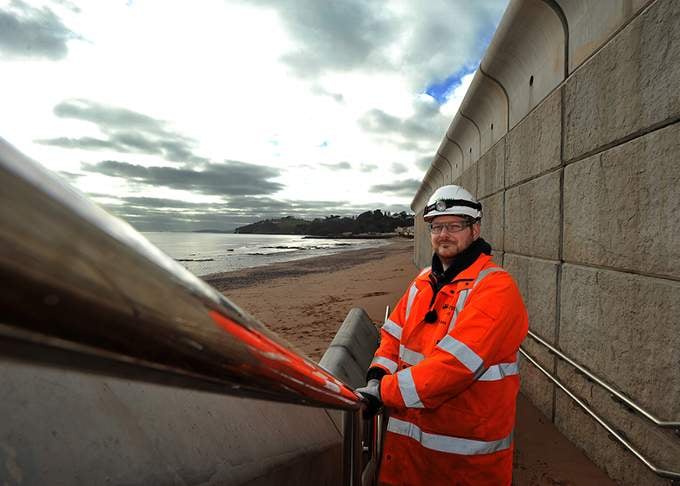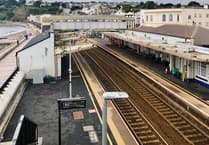WORK to protect the railway line through Dawlish is progressing at pace nearly a decade on from storms which saw parts of the route washed away.
Today [Friday] marks eight years to the day since the infamous 2014 storm which severely damaged the railway on the South Devon coastline.
Since construction began on the first section of new, bigger sea wall in May 2019, the Dawlish coastline has undergone a mighty transformation.
The first phase – which runs for 360 metres along Marine Parade south west of Dawlish station – was completed in July last year.
Construction of the 415 metre second section – stretching from Coastguard breakwater east of Dawlish station to Colonnade breakwater – began in November 2020.
Work on this second section is progressing well, with Network Rail’s contractors BAM Nuttall having successfully installed all 143 concrete wall panels and curved wave returns on top of the panels.
The design of the panels and wave returns, coupled with the increased height of the wall, is already keeping the tracks flood-free and train services running.
The promenade along the second section is starting to take shape and the steps down to the beach at Coastguard breakwater have been completed.
Engineers have been able to re-purpose some of the old sea wall as seating in this area, while there is also artwork etched into the structure in a nod to the old boathouse. Coastguard’s footbridge expected to reopen later this month.
Engineers are now focussing efforts on temporarily diverting the Dawlish river water as part of work on the new stilling basin, while continuing to install the remaining piles.
Work is also underway to completely rebuild the seaward platform one and resurface the landward platform two.
A team of engineers will be working around the clock over four consecutive weekends in February to complete this work.
The line is set to be closed from 4am on Saturday morning to 1am on Monday morning for four weeks, starting this weekend.
Rail replacement busses will be in use, and GWR is asking those intending to travel during this period to plan ahead and check journey times before travelling.
Yan Sayles, BAM Nuttall project manager, said: ‘Dawlish has been a job like no other. The location of the railway, sandwiched between the sea and the town, has made delivering the work incredibly challenging but enormously rewarding.
‘It has pushed us to the limits of our knowledge and required us to develop new techniques and materials that have never been used in other rail projects before.
‘I’d like to thank the residents of Dawlish for their patience, hospitality and friendship over our years delivering this work.
‘We know our work has sometimes caused noise and disturbance, but we hope that it will provide a lasting legacy which will benefit the town for many years to come.
‘BAM and our suppliers are extremely proud of the work we’re delivering in Dawlish and I’d like to express my gratitude to everyone who has contributed to the effort so far.’
Cllr Val Mawhood, Mayor of Dawlish, added: ‘The great storm of 2014 is now a major part of Dawlish history and something that will be spoken about for generations to come.
‘This awful event showed just how vital this section of the rail network is for the whole of the South West and I welcome the progress which has been made on the new sea wall. This is already having a positive impact on the town and will ensure that history isn’t repeated.’
Pick up next Thursday’s Dawlish Gazette for a look back over the past eight years – plus in-depth interviews with Network Rail project manager Phil Morton and BAM Nuttall project manager Yan Sayles.





Comments
This article has no comments yet. Be the first to leave a comment.